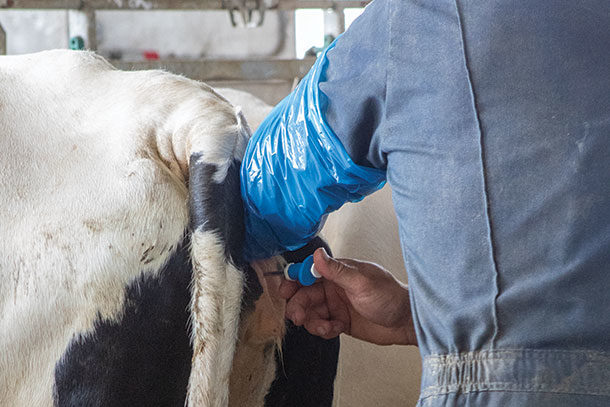It is very well documented that the most important parameter to be evaluated in the modern dairy operation is pregnancy rate (PR). This is defined as the percentage of eligible cows that become pregnant within a given time frame, commonly the 21-day period of the average cow’s estrous cycle.
The 21-day PR is compounded by insemination risk (IR), which represents the percentage of eligible cows inseminated within a time frame, and by conception rate (CR), which is the total number of pregnant animals divided by the total number of inseminated cows with known results. When PR increases in a herd, days in milk (DIM) decreases over time because we have higher milk production per day and more cows within their most profitable portion of lactation.
On the other hand, when PR decreases, DIM tends to increase over time. This is because there are more cows producing milk for a longer period, including more time in the least profitable period. This situation can also drive related cost increases, such as veterinary assistance, feeding, and breeding supplies and services.
Many factors influence PR. One of the most important is very basic: Are cows being inseminated in heat? Heat detection accuracy is a fundamental component of an efficient reproductive program. Failure to detect heat and errors in heat detection are the two primary causes of poor reproductive performance and low fertility. Research indicates 7% to 20% of cows inseminated are not in heat. Inadequate heat detection affects profitability in many different ways. Among these are:
- Longer calving intervals with fewer calves and lower lifetime milk production
- Cows bred when not in heat decreases CR and wastes semen and labor
- Low CR may lead to culling reproductively sound cows
- Breeding pregnant cows due to poor heat detection may cause abortion
To breed, or not to breed: That is the question
In large dairies, the most common technique for heat detection is through a once-a-day heat evaluation. One common method is the application of tail chalk or paint spray on all eligible cows. Animals that are later seen with those markers rubbed off, or with ruffled hair on the tailhead, are deemed to be in heat. It is important that the A.I. technician handles information in real time through paper lists or a scanner linked to the herd database to understand the current situation of each animal. Knowing DIM, when the last insemination occurred, if they are still in the voluntary waiting period (VWP) and what type of semen should be used, are among key factors to consider.
Cows with markers partially rubbed off are “inviting” the technician to have a closer “talk,” by looking for secondary signs of heat. These can include seeking for clear mucus discharge (many times through rectal palpation), a swollen vulva, dirty flanks, as well as higher back sensitivity. The A.l. technician should make the decision to breed only after considering all this information.
Evaluate technician performance
After some hundreds of inseminations, the technician’s performance may be evaluated. Clearly, this should proceed in an accurate and fair way. First, we need to have a considerable number of events. Dr. Joe Dalton from the University of Idaho recommends at least 250 observations per technician. It’s also important to split the number by breeding code (heat detection versus timed A.I., for example) and lactation number, mainly because we need to know if they are breeding the same type of cows, using the same sires, in the same season of the year, and any other factor that may interfere with accurately comparing one technician against another or within another group. A comparison should not be made based upon a small number of observations. Such a decision, based on insufficient data, would be reckless and could cost the technician his or her job.
There are additional factors to be considered. For example, comparing the main technician to a relief worker, who breeds only one day a week, will be hard to do fairly because the number of events will be disproportional. Also, the main breeder knows the cows much better, especially their behavior and patterns of heat in that environment. This superior understanding of the herd should give the main technician an advantage in any comparison. Moreover, there are instances where there are two technicians (or more), but only one of them does heat detection. If they then split A.I. procedures (semen handling and A.I. technique) it should be recognized that the key breeding decision is made by only one technician.
Common errors in breeder performance
Of course, a good breeder should be very careful with habits and overall cleanliness during semen handling and A.I. preparation. It’s not our intention to review all the steps on these procedures here, but a very common mistake is thaw units with lower or higher temperatures than the ideal range of 94 to 98°F.
During the insemination technique, two common errors are the deposition of semen before the target (still in the cervix) and/or a too fast semen deposition, which should take around five seconds to maximize an equal semen flow into the uterine horns. Both conditions may cause lower CR.
After a fair analysis has identified an A.I. technician whose work yields a lower-than-average CR, we can estimate the cost of that poor performance. Let’s say technician A produces 150 fewer pregnancies than technician B. If we consider a pregnancy to be worth around $200, the difference is about $30,000, due only to the difference between A.I. technicians during that time frame.
That number shouldn’t be used to carry out a “witch hunt” but should alert the owner or manager to an opportunity to organize A.I. retraining sessions with the whole team. Such training should include heat detection accuracy, semen handling and insemination technique. As literature and our daily basis observations reveal, A.I. retraining sessions can improve considerably the performance of both in-house and professional technicians.






